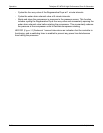
Teledyne API M701H High Performance Zero Air Generator Operation
06712B (DCN5875) 5-9
5.2.13 CO Scrubber
The CO scrubber catalytically oxidizes CO to CO
2
. The catalyst is proprietary and
operates at room temperature; theoretically, it should never need changing. However, it
may become contaminated or poisoned over time so we recommend that it be replaced
once per year or sooner if the level of CO in the air is high.
5.2.14 NO Scrubber
The NO scrubber uses Purafil
®
to oxidize NO to NO
2
. Purafil
®
has a finite life and we
recommend that it be replaced annually or sooner if the level of NO in the air is high.
5.2.15 Charcoal Scrubber
Activated charcoal removes NO
2
, O
3
, SO
2
and H
2
S. The charcoal should be replaced
annually or sooner if there are high atmospheric levels of these contaminants, or if the
calibrator zero air shows signs of a positive drift.
5.2.16 Final Filter
The final filter, inside the rear panel retains any particulates released by the M701H.
The filter rating is 10 microns. If the filter becomes restricted, it should be disassembled
and cleaned, or the element be replaced.
5.2.17 Controller
WARNING
DANGEROUS VOLTAGES EXIST ON THE CONTROLLER BOARD
EVEN WHEN THE POWER SWITCH IS TURNED OFF.
All functions of the M701H are managed by the M701H Control PCB. The M701H
Control PCB provides connections for all switched and non-switched AC components,
AC input, and the front panel power switch/circuit breaker. Non-switched components
include the CO or HC scrubber, fan and front panel power indicator. Switched
components include the Regenerative Dryer valve, water drain valve, and the pump.
Additionally, the tank pressure switch is connected to the PCB. Provision for 120v/240v
AC power is via a jumper plug/autotransformer connector (J2). All connections are
made by quick release electrical connectors to aid in servicing. Refer to Figure 5-3 for
the layout and to Appendix B for the interconnect and other drawings.
The M701H Control PCB is microcontroller based, and all timing is derived from the AC
line. It automatically senses the line frequency (50/60 Hz) and provides the following
functions:


















